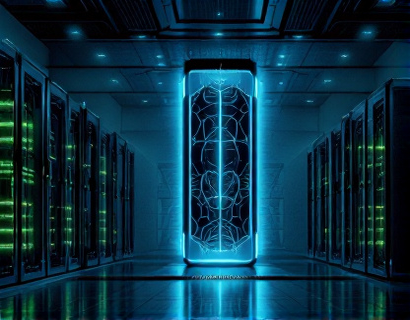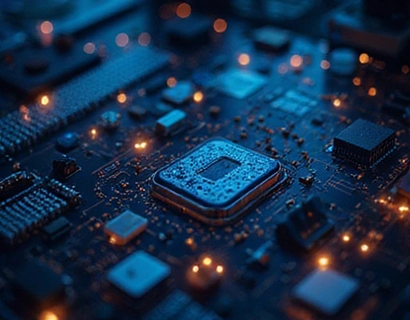Blockchain-Powered Registry Solutions: Elevating Data Management with Security, Transparency, and Efficiency
In the digital age, the management of critical data has become a paramount concern for organizations across various sectors. Traditional registry systems often struggle with issues such as data integrity, security, and efficiency. Blockchain technology offers a revolutionary approach to address these challenges, providing a robust framework for secure, transparent, and efficient data management. This article delves into the transformative potential of blockchain-powered registry solutions, highlighting their benefits for registry management professionals, data security advocates, and digital transformation leaders.
Understanding Blockchain Technology
Before exploring the applications of blockchain in registry management, it is essential to understand the fundamental principles of blockchain technology. At its core, a blockchain is a decentralized digital ledger that records transactions across multiple computers in such a way that the registered transactions cannot be altered retroactively. This immutability is achieved through a combination of cryptographic hashing and consensus mechanisms, ensuring that once data is recorded, it remains tamper-proof.
Blockchain consists of blocks, each containing a list of transactions. Each block is linked to the previous one through a cryptographic hash, forming a chain. This structure not only ensures data integrity but also enhances transparency, as all participants in the network can view the entire chain. The decentralized nature of blockchain means that no single entity has control over the entire network, reducing the risk of centralized points of failure and increasing resilience against cyber threats.
Enhanced Security in Registry Management
One of the most significant advantages of blockchain-powered registry solutions is the enhanced security they provide. Traditional registry systems are often vulnerable to data breaches, unauthorized access, and manipulation. Blockchain's inherent security features mitigate these risks through several mechanisms.
Firstly, the cryptographic hashing used in blockchain ensures that any alteration to the data is immediately detectable. Each block's hash is dependent on the previous block's hash, creating an unbreakable chain. Any attempt to modify a block would require altering all subsequent blocks, which is computationally infeasible due to the consensus mechanisms in place.
Secondly, blockchain's decentralized nature eliminates the risk of a single point of failure. Data is distributed across a network of nodes, making it extremely difficult for malicious actors to compromise the entire system. This distributed architecture also enhances data availability and reliability, as the system can continue to function even if some nodes fail.
Furthermore, blockchain employs advanced encryption techniques to protect data privacy. Each transaction is encrypted, ensuring that sensitive information remains confidential. Access to the data is controlled through private and public keys, allowing only authorized parties to view or modify specific records. This level of encryption and access control significantly reduces the risk of unauthorized data access and ensures compliance with data protection regulations.
Transparency and Trust
Transparency is a cornerstone of blockchain technology, and it plays a crucial role in building trust within registry management systems. The immutable and transparent nature of blockchain ensures that all transactions are visible to all participants in the network. This visibility fosters accountability and trust among stakeholders, as they can independently verify the accuracy and integrity of the data.
In traditional registry systems, trust is often placed in a central authority to manage and validate data. This centralization can lead to issues such as corruption, bias, and lack of accountability. Blockchain eliminates the need for a central authority by distributing trust across the network. Each participant has a copy of the entire ledger, and consensus mechanisms ensure that all transactions are valid and agreed upon by the majority.
For example, in land registry management, blockchain can provide a transparent and tamper-proof record of property ownership. Stakeholders, including buyers, sellers, and regulatory bodies, can access the same version of the truth, reducing disputes and increasing efficiency. This transparency not only enhances trust but also streamlines processes, reducing the need for intermediaries and associated costs.
Efficiency and Automation
Blockchain technology not only enhances security and transparency but also significantly improves the efficiency of registry management processes. Smart contracts, self-executing contracts with the terms directly written into code, are a key feature of blockchain that can automate and streamline various tasks.
Smart contracts can be programmed to automatically execute actions when predefined conditions are met. For instance, in a property registry, a smart contract can automatically update ownership records once a transfer is completed and all necessary conditions, such as payment and legal verification, are satisfied. This automation reduces manual intervention, minimizes human error, and accelerates processes.
Additionally, blockchain's real-time data synchronization ensures that all participants have access to the most up-to-date information. This real-time visibility eliminates the need for manual data reconciliation and reduces the time required to resolve discrepancies. In supply chain management, for example, blockchain can provide real-time tracking of goods, ensuring that all parties have accurate and timely information, which enhances overall supply chain efficiency.
Use Cases in Various Industries
The applications of blockchain-powered registry solutions extend across multiple industries, each benefiting from the unique advantages of blockchain technology.
In the healthcare sector, blockchain can secure patient records, ensuring that medical data is accurately maintained and easily accessible to authorized personnel. This not only improves patient care but also enhances data privacy and compliance with regulations such as HIPAA.
In the financial industry, blockchain can revolutionize the way securities and assets are traded and managed. Blockchain-based platforms can reduce the time and cost associated with traditional settlement processes, enhance transparency in transactions, and minimize the risk of fraud.
In government and public sector, blockchain can transform the management of public records, voting systems, and identity verification. For instance, blockchain-based voting systems can ensure the integrity and transparency of elections, reducing the risk of tampering and increasing voter confidence.
Challenges and Considerations
While the benefits of blockchain-powered registry solutions are compelling, there are several challenges and considerations that organizations must address when implementing these systems.
Firstly, scalability remains a significant challenge for many blockchain platforms. As the number of transactions increases, the network can become congested, leading to slower transaction times and higher costs. However, ongoing developments in blockchain technology, such as layer 2 solutions and sharding, are addressing these scalability issues.
Secondly, the regulatory landscape for blockchain is still evolving, and organizations must navigate varying legal requirements across different jurisdictions. Ensuring compliance with data protection laws, such as GDPR, is crucial when implementing blockchain solutions.
Thirdly, the adoption of blockchain technology requires a cultural shift within organizations. Embracing decentralization and trustless systems can be challenging for entities accustomed to centralized control. Education and training are essential to foster a blockchain-ready mindset among employees and stakeholders.
Future Trends and Innovations
The future of blockchain-powered registry solutions is promising, with ongoing innovations set to further enhance their capabilities and adoption.
Interoperability is a key area of focus, with efforts to develop standards that allow different blockchain networks to communicate and share data seamlessly. This interoperability will enable more comprehensive and integrated registry systems, breaking down silos and enhancing data utility.
Another exciting development is the integration of blockchain with other emerging technologies, such as the Internet of Things (IoT) and artificial intelligence (AI). IoT devices can generate and record data on the blockchain, ensuring its integrity and traceability. AI can be used to analyze blockchain data, providing insights and automating decision-making processes.
Furthermore, the rise of decentralized finance (DeFi) and non-fungible tokens (NFTs) is opening new avenues for registry management. Blockchain can securely and transparently manage digital assets, intellectual property, and unique digital identities, creating new opportunities for organizations and individuals.
Conclusion
Blockchain-powered registry solutions offer a transformative approach to data management, addressing the critical needs of security, transparency, and efficiency. By leveraging the inherent strengths of blockchain technology, organizations can enhance their registry processes, build trust, and drive digital transformation. While challenges exist, the ongoing advancements and innovations in the field are paving the way for a more secure, transparent, and efficient future in data management.










































